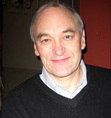Michael Dobbs's Blog, page 2
August 1, 2019
storm clouds over the U.k.
 I was recently back in the U.K., to visit my daughter in Scotland. We hiked to a lovely loch in the highlands, but storm clouds were gathering, and we came back drenched. A metaphor for Brexit!
I was recently back in the U.K., to visit my daughter in Scotland. We hiked to a lovely loch in the highlands, but storm clouds were gathering, and we came back drenched. A metaphor for Brexit!As an expatriate Brit who moved to the United States more than two decades ago, I have been trying to figure out the transformation that has overcome my native and adopted countries. Traditionally, we Anglo-Saxons have prided ourselves on our pragmatism and moderation. For decades, our systems of government were models for the rest of the world. Why have we suddenly become playgrounds for flag-waving nationalists, as exemplified by Donald Trump in the U.S. and Boris Johnson in Britain?
Part of the answer, I think, lies in our curious, first past-the-post voting systems which makes it possible for an unpopular leader to take power without majority support, as long as he faces a divided opposition. The bottom line is that we do not vote directly for our leaders, either in the U.S. or in the U.K. Instead we have an electoral college mechanism that rewards conviction politicians who are able to pile up votes in the right places, but does not necessarily reflect the wishes of the majority of the population.
I expand on these arguments in an op-ed piece that I wrote for The Washington Post, which you can find here.
Published on August 01, 2019 12:40
March 15, 2019
printed books vs. e-books
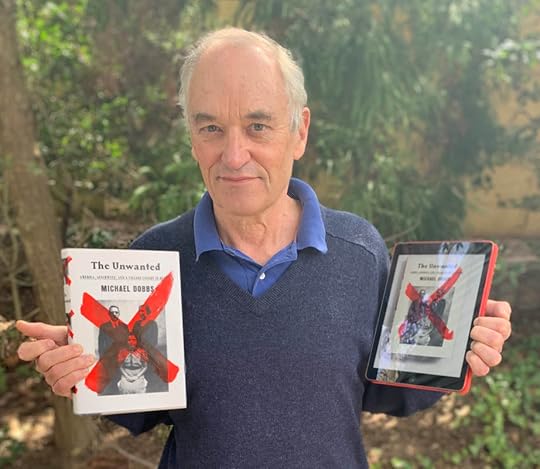 Even for the author of six books, there is still something magical about holding the finished product in your hands for the very first time. Today, I received advance copies of my latest opus,
The Unwanted: America, Auschwitz, and a Village Caught in Between
, which will be released on April 2. I hope you will agree that the publisher, Knopf, has done an exceptional job.
Even for the author of six books, there is still something magical about holding the finished product in your hands for the very first time. Today, I received advance copies of my latest opus,
The Unwanted: America, Auschwitz, and a Village Caught in Between
, which will be released on April 2. I hope you will agree that the publisher, Knopf, has done an exceptional job.This may be a slight exaggeration, but I think of Knopf (founded by Alfred A. Knopf and his wife Blanche in 1915) as the last of America’s “gentleman publishers.” They are a throwback to the age when editors treated writers with enormous courtesy, inviting them to long lunches and tolerating multi-year delays in the submission of manuscripts. They are also renowned for their gorgeously produced books. Even though Knopf is now part of a German-owned conglomerate, a Knopf book includes a number of design features, such as rough deckle edges and high quality paper, that make it easily recognizable.
This time, as a special treat, I had the opportunity to see my book roll off the presses. Knopf books are printed in a small town in the Shenandoah Valley in Virginia called Berryville, an hour’s drive from Washington D.C. where I live. It turns out that this charming, but otherwise insignificant town (population 4,185) is the location of one the largest printing operations in the United States, producing more than 10 million books a month.
When I arrived, high-speed offset presses were churning out yet another reprint of Michelle Obama’s autobiography, Becoming, which has already sold some five million copies in the U.S. alone. In a different corner of the plant, my book was being printed in 32-page sections, known as “signatures,” which are most suitable for binding. In the photograph below, you can see the proud author holding a completed signature of The Unwanted, while a worker throws slightly imperfect versions into the trash.
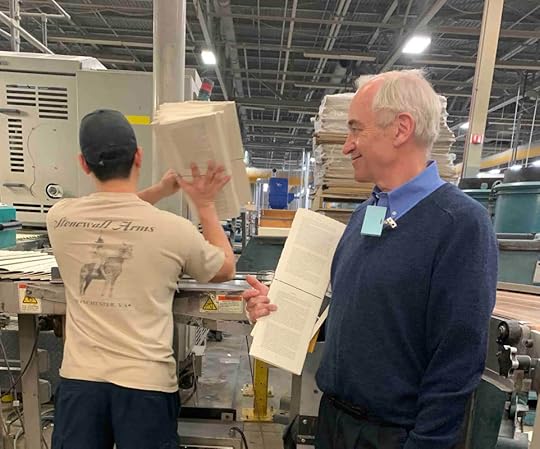 My main takeaway from my visit to Berryville was how old-fashioned the printing process remains. For all the technological advances of recent years, the basic techniques of book production are essentially little changed from the days of Johannes Gutenberg in the 15th century. Ink is smeared onto paper through a mechanized process, and then bound into books with covers made out of pressed cardboard. The typefaces used in my book were designed by a Dutchman in the 17th century.
My main takeaway from my visit to Berryville was how old-fashioned the printing process remains. For all the technological advances of recent years, the basic techniques of book production are essentially little changed from the days of Johannes Gutenberg in the 15th century. Ink is smeared onto paper through a mechanized process, and then bound into books with covers made out of pressed cardboard. The typefaces used in my book were designed by a Dutchman in the 17th century.Like many of you, I suspect, I went through a phase of reading books on a Kindle or an I-Pad. But today, I greatly prefer the tactile sensation of handling a physical book. After many hours gazing into computer screens and smart phones, it is much more relaxing to curl up with a beautifully produced book than yet another electronic device. It is also much easier to move back and forth in a book, consulting an endnote or refreshing your memory about a character who has appeared in an earlier chapter.
Six hundred years after its invention, the physical book is not only competitive with any of our modern technologies. With the possible exception of portability, it is superior in nearly every respect. In an age of bewildering change, that is immensely reassuring.
Published on March 15, 2019 11:17
February 19, 2019
persuading the reader to turn the page
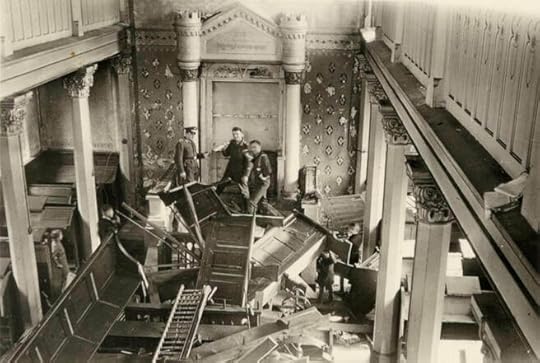 Destruction of Kippenheim synagogue, November 10, 1938 With a new book coming out in April, I wanted to share some thoughts on the art of historical narrative. As I mentioned in my last blog post, I believe that the methods of fiction can be applied to non-fiction with one very large caveat: you can’t make anything up. The number one lesson that I take away from the writers I admire--whether they are novelists or historians--is to immerse the reader as deeply as possible in the story that I am telling and the times I am writing about.
Destruction of Kippenheim synagogue, November 10, 1938 With a new book coming out in April, I wanted to share some thoughts on the art of historical narrative. As I mentioned in my last blog post, I believe that the methods of fiction can be applied to non-fiction with one very large caveat: you can’t make anything up. The number one lesson that I take away from the writers I admire--whether they are novelists or historians--is to immerse the reader as deeply as possible in the story that I am telling and the times I am writing about.I am a traditionalist when it comes to the principles of story-telling. I prefer to read (and write) history books with a clear beginning, middle, and end. The plot should unfold naturally and sequentially, building to a culminating point in the narrative, when the dilemmas confronting your characters are somehow resolved, either happily or tragically. Subtle foreshadowing (viz. the gun on the wall in the first act of a Chekhov play) is permissible, but the author must never get ahead of the story he or she is telling.
It seems hardly coincidental that the most successful of our modern-day historians are also accomplished writers who know how to construct a powerful narrative. My personal role models include David McCullough and Edmund Morris (for his three-part Theodore Roosevelt biography, not the partly-fictionalized biography of Ronald Reagan). Both McCullough and Morris are adept at keeping their stories moving forward, weaving necessary background into the narrative without slowing it down.
The trouble with history, of course, is that we typically know how the story ends, in contrast to novels, where the suspense is maintained until the very last moment. There is no mystery about who won World War II or what happened to the Soviet Union. To draw on the plot of one of my previous books, One Minute to Midnight , we know very well that the world did not come to an end in October 1962. You might think this would remove much of the suspense from the story of the Cuban missile crisis but this was not the case in my experience. The excitement derives not from how the story ends, but from the twists and turns along the way.
One of my favorite historians, Barbara Tuchman, described this phenomenon well in her essay, In Search of History. Initially, she worried “a good deal” about the “the problem of keeping up suspense in a narrative whose outcome is known.” After a while, she discovered that the problem resolved itself. “If one writes as of the time, without using the benefit of hindsight, resisting always the temptation to refer to events still ahead, the suspense will build itself up naturally.” She cites the example of Marshal Joffre hesitating before the Battle of the Marne in 1914, when the French army prevented the Germans from marching on Paris. Even though the result of the battle is well known, the suspense becomes “almost unbearable, because one knows that if he had made the wrong decision, you and I might not be here today.”
Another good example is Frederick Forsyth’s thriller novel, The Day of the Jackal, which describes the attempted assassination of Charles de Gaulle. Anyone even vaguely familiar with modern French history knows very well that the plot fails and General de Gaulle survives. Nevertheless, Forsyth engrosses us so completely in his meticulous descriptions of the assassin’s preparations that we keep turning the pages to find out what goes wrong.
In addition to maintaining suspense, the narrative method sidesteps the curse of omniscient hindsight, an affliction of many historians. This is particularly acute with shattering events such as the Holocaust that have colored our entire understanding of 20th century history. We should resist the temptation to project out current-day knowledge backwards when examining the choices made by politicians before the annihilation of six million Jews. While we can certainly criticize the failure of Franklin Roosevelt and other American leaders to do more to assist refugees fleeing from Hitler, it is unfair to paint them as complicit in events that had not yet taken place.
The nineteenth century Danish philosopher, Søren Kierkegaard, once observed that history is “lived forwards” but “understood backwards.” Historians like to find order, logic, and inevitability in events that sometimes defy coherent and logical explanation. One way to correct this bias is to relate historical events as they happened, from the point of view of the people who lived through them. By telling the story forwards (as experienced) rather than backwards (as now understood), we can re-create its cliff-hanging excitement and unpredictability. We also gain new insights into the actions and motivations of the principal players.
That, at least, has been the philosophy that has guided me through the writing of six non-fiction books. In my latest book, The Unwanted , I tell the story of a group of German Jews attempting to flee Nazi persecution. The opening scene describes the shattering events of Kristallnacht, on November 10, 1938, in a village on the edge of the Black Forest. (See photograph above.) This is the moment when the Jews of Kippenheim realize that there is no alternative to emigration from Germany if they are to survive. Their preferred destination is the United States, although they are willing to settle for other places of refuge.
In keeping with Barbara Tuchman’s advice, I resist the temptation to jump forward to events that have not yet happened. Instead I recount, as accurately and vividly as possible, the various obstacles they encounter and their frantic efforts to overcome them. Intertwined with the story of the refugees is the story of U.S. immigration policy under Roosevelt.The tension builds naturally as the families with whom we become acquainted in the opening chapter organize their attempted escapes from Europe. Some of them make it to the promised land across the ocean. Others end up in Auschwitz, their applications for American visas “still pending.” I hope you find the story as alternately inspiring, heart-breaking, and exciting as I did, when I researched and wrote it.
Published on February 19, 2019 05:32
January 21, 2019
Books that have inspired me
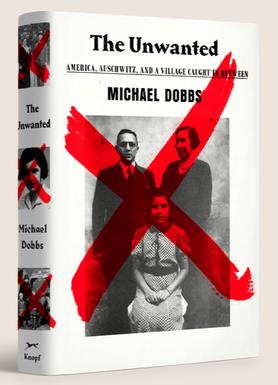 My latest book, The Unwanted, will be published on April 2. It is about the life-or-death struggle of Jews fleeing Nazi persecution to obtain a safe haven across the ocean. In order to emphasize the human drama, I focus on the fates of Jewish families from a single village on the edge of the Black Forest, in southwestern Germany. The overarching story line is tragically simple: the people featured in the book either get to America or they perish in Auschwitz. In the process of telling their stories, I examine the reasons why they ended up where they did, which are connected to the U.S. immigration policy of the time.
My latest book, The Unwanted, will be published on April 2. It is about the life-or-death struggle of Jews fleeing Nazi persecution to obtain a safe haven across the ocean. In order to emphasize the human drama, I focus on the fates of Jewish families from a single village on the edge of the Black Forest, in southwestern Germany. The overarching story line is tragically simple: the people featured in the book either get to America or they perish in Auschwitz. In the process of telling their stories, I examine the reasons why they ended up where they did, which are connected to the U.S. immigration policy of the time.Having now written six books, this seems a good opportunity to reflect on my writing methods and sources of inspiration. Needless to say, I have been greatly influenced by other books and other writers. I agree with the advice given to aspiring writers by the thriller novelist Steven King in his now classic On Writing. “If you want to be a writer, you must do two things above all others: read a lot and write a lot.”
You might think that, as a non-fiction writer, I would read primarily non-fiction, but this is not the case. Most of my reading, particularly when I am in search of literary models, is fiction. My reading list during the two years that I researched and wrote The Unwanted is full of the great nineteenth century novelists like Charlotte Bronte, Charles Dickens, Jane Austen, and Anthony Trollope (a recent, unexpected pleasure). It includes twentieth century writers who have stood the test of time (Evelyn Waugh, George Orwell, Ernest Hemingway, Nancy Mitford, C.S. Forester, Wilkie Collins, Laurence Durrell, Eric Ambler), and a sprinkling of modern novelists (John Le Carré, Robert Harris, Alan Furst, Ken Follett, John Grisham.)
It is not that I have stopped reading non-fiction entirely. As I worked on The Unwanted, I consulted many histories of the period leading up to the Holocaust, and even read a few of them cover-to-cover. One book I found particularly helpful was The Pity of It All by Amos Elon, which looks at the Jewish experience in Germany over two centuries, up to Hitler’s assumption of power in 1933. I was captivated by Varian Fry’s lively memoir, Surrender on Demand, describing his experiences in unoccupied France between 1940 and 1941 rescuing intellectuals, artists, and other public figures on the run from Hitler. For the most part, however, I read (or perused) histories of the period mainly for research purposes rather than for enjoyment. As guides on how to write a compelling narrative, I looked elsewhere.
If there is a single book that I used as a model for The Unwanted, it is probably A Tale of Two Cities by Charles Dickens. Just as Dickens draws an unforgettable portrait of a city caught up in the turmoil of revolution (Paris), juxtaposed with a city of relative calm and prosperity (London), I was interested in the contrast between a continent at war (Europe) and a continent at peace (America). I considered A Tale of Two Continents as a possible title for my book but discarded it in favor of The Unwanted in order to focus on the people seeking refuge. But I pay homage to Dickens with a quote at the very beginning of the book, “It was the season of Light, it was the season of Darkness, it was the spring of hope, it was the winter of despair, we had everything before us, we had nothing before us, we were all going direct to Heaven, we were all going direct the other way.”
A now almost forgotten novel that helped me get a feel for the nightmarish refugee experience in Europe resulting from the rise of Hitler was Transit by Anna Seghers. Herself a refugee from Nazism, Seghers provides a vivid account of the bureaucratic maze that confronted refugees as they ran from one consulate to another in pursuit of the rubber stamps and documents that would save their lives. Much of her novel is set in Marseille, the great port on the Mediterranean that is also the transit city for some of the characters in my book. I cite her descriptions of the stone-faced consuls “who make you feel as if you’re nothing” and the “frizzy-haired bureaucratic goblins” of the French police, with their passion for “sorting, classifying, registering, and stamping” the desperate people passing through their doors.
One of the kindest reviews I have ever received, for my book One Minute to Midnight on the Cuban missile crisis, compared my writing style to John le Carré and Alan Furst, two novelists I greatly admire. In emulating some of their techniques, I understand of course that non-fiction writers are different from writers of fiction in one crucial, very obvious, respect: We are not allowed to make anything up! This raises some interesting questions about the boundaries and overlap between fiction and non-fiction that I intend to explore in a series of future blog posts.
Published on January 21, 2019 11:37
October 29, 2012
When did the Cold War begin?
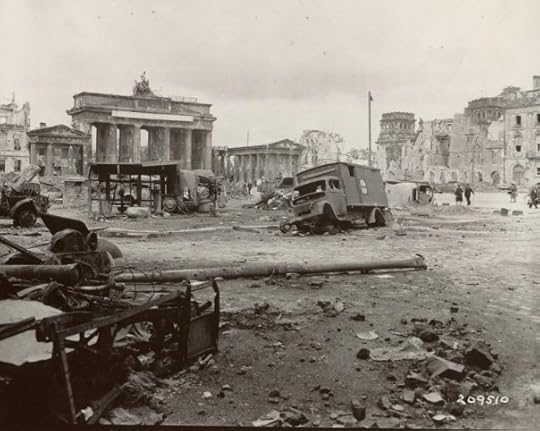 We all know when the Cold War ended: with the fall of the Berlin wall in November 1989. When it began is much more controversial. In my new book, Six Months in 1945, I say that it began in the six month period between the Yalta conference in February 1945 and the bombing of Hiroshima in August 1945. I also argue that it was the inevitable outgrowth of World War II. When Americans and Russians met in the heart of Europe in April 1945, they turned, almost overnight, from World War II allies into Cold War rivals.
We all know when the Cold War ended: with the fall of the Berlin wall in November 1989. When it began is much more controversial. In my new book, Six Months in 1945, I say that it began in the six month period between the Yalta conference in February 1945 and the bombing of Hiroshima in August 1945. I also argue that it was the inevitable outgrowth of World War II. When Americans and Russians met in the heart of Europe in April 1945, they turned, almost overnight, from World War II allies into Cold War rivals.For more on my reasoning, and why I differ with other historians, see an article that I just wrote for the History News Network. And, of course, read my book!
Published on October 29, 2012 09:20
When did the Cold War begin?
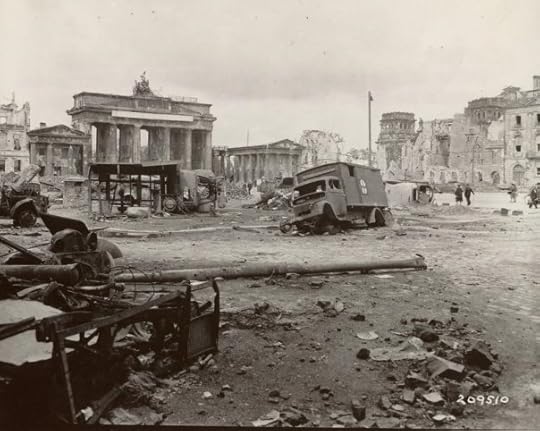 We all know when the Cold War ended: with the fall of the Berlin wall in November 1989. When it began is much more controversial. In my new book, Six Months in 1945, I say that it began in the six month period between the Yalta conference in February 1945 and the bombing of Hiroshima in August 1945. I also argue that it was the inevitable outgrowth of World War II. When Americans and Russians met in the heart of Europe in April 1945, they turned, almost overnight, from World War II allies into Cold War rivals.
We all know when the Cold War ended: with the fall of the Berlin wall in November 1989. When it began is much more controversial. In my new book, Six Months in 1945, I say that it began in the six month period between the Yalta conference in February 1945 and the bombing of Hiroshima in August 1945. I also argue that it was the inevitable outgrowth of World War II. When Americans and Russians met in the heart of Europe in April 1945, they turned, almost overnight, from World War II allies into Cold War rivals.For more on my reasoning, and why I differ with other historians, see an article that I just wrote for the History News Network. And, of course, read my book!
Published on October 29, 2012 08:20
October 22, 2012
Fifty years ago....
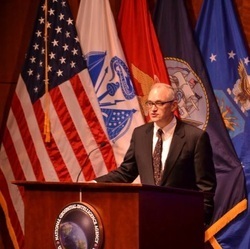 I have been invited to numerous events commemorating the 50th anniversary of the Cuban missile crisis, the subject of my book, One Minute to Midnight. The invitation that gave me most pleasure, however, was to be asked to address 500 photo intelligence analysts from the National Geospatial Intelligence Agency. I was joined on stage by two of the analysts who discovered the Soviet missiles back in October 1962, Dino Brugioni and Vincent DiRenzo. I was tell them what they missed back in 1962. The president kept on asking them "Where are the nuclear warheads?" but they were never able to answer that question conclusively.In One Minute to Midnight, I solve this mystery, identifying the nuclear warhead bunker near Bejucal where the warheads were stored.Of course I had one big advantage that the intelligence analysts did not enjoy at the time. Writing about the missile crisis nearly half a century later, I was able to talk to Soviet veterans who had responsibility for looking after the nuclear warheads. Hindsight is a wonderful thing!
I have been invited to numerous events commemorating the 50th anniversary of the Cuban missile crisis, the subject of my book, One Minute to Midnight. The invitation that gave me most pleasure, however, was to be asked to address 500 photo intelligence analysts from the National Geospatial Intelligence Agency. I was joined on stage by two of the analysts who discovered the Soviet missiles back in October 1962, Dino Brugioni and Vincent DiRenzo. I was tell them what they missed back in 1962. The president kept on asking them "Where are the nuclear warheads?" but they were never able to answer that question conclusively.In One Minute to Midnight, I solve this mystery, identifying the nuclear warhead bunker near Bejucal where the warheads were stored.Of course I had one big advantage that the intelligence analysts did not enjoy at the time. Writing about the missile crisis nearly half a century later, I was able to talk to Soviet veterans who had responsibility for looking after the nuclear warheads. Hindsight is a wonderful thing!
Published on October 22, 2012 13:07
Fifty years ago....
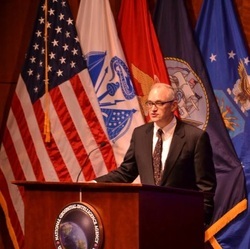 I have been invited to numerous events commemorating the 50th anniversary of the Cuban missile crisis, the subject of my book, One Minute to Midnight. The invitation that gave me most pleasure, however, was to be asked to address 500 photo intelligence analysts from the National Geospatial Intelligence Agency. I was joined on stage by two of the analysts who discovered the Soviet missiles back in October 1962, Dino Brugioni and Vincent DiRenzo. I was tell them what they missed back in 1962. The president kept on asking them "Where are the nuclear warheads?" but they were never able to answer that question conclusively.In One Minute to Midnight, I solve this mystery, identifying the nuclear warhead bunker near Bejucal where the warheads were stored.Of course I had one big advantage that the intelligence analysts did not enjoy at the time. Writing about the missile crisis nearly half a century later, I was able to talk to Soviet veterans who had responsibility for looking after the nuclear warheads. Hindsight is a wonderful thing!
I have been invited to numerous events commemorating the 50th anniversary of the Cuban missile crisis, the subject of my book, One Minute to Midnight. The invitation that gave me most pleasure, however, was to be asked to address 500 photo intelligence analysts from the National Geospatial Intelligence Agency. I was joined on stage by two of the analysts who discovered the Soviet missiles back in October 1962, Dino Brugioni and Vincent DiRenzo. I was tell them what they missed back in 1962. The president kept on asking them "Where are the nuclear warheads?" but they were never able to answer that question conclusively.In One Minute to Midnight, I solve this mystery, identifying the nuclear warhead bunker near Bejucal where the warheads were stored.Of course I had one big advantage that the intelligence analysts did not enjoy at the time. Writing about the missile crisis nearly half a century later, I was able to talk to Soviet veterans who had responsibility for looking after the nuclear warheads. Hindsight is a wonderful thing!
Published on October 22, 2012 12:07
October 16, 2012
Out today!
My latest book, Six Months in 1945, is out today! It tells the story of the beginning of early days of the Cold War, how Americans and Russians met each other in the heart of Europe and decided that they didn't like each other after all. In the space of just six months, the U.S. and the Soviet Union went from being WWII allies to Cold War rivals.
By coincidence, this is the day the "Thirteen Days" began ticking in the Cuban missile crisis, when JFK was told about the presence of Soviet missiles on Cuba ln October 16,1962. I punctuate some of the mythology surrounding the crisis in a piece for the New York Times here. I make the point that our political leaders learned the wrong lessons from the crisis, and got into unnecessary wars in Vietnam and Iraq.
By coincidence, this is the day the "Thirteen Days" began ticking in the Cuban missile crisis, when JFK was told about the presence of Soviet missiles on Cuba ln October 16,1962. I punctuate some of the mythology surrounding the crisis in a piece for the New York Times here. I make the point that our political leaders learned the wrong lessons from the crisis, and got into unnecessary wars in Vietnam and Iraq.
Published on October 16, 2012 11:58
Out today!
My latest book, Six Months in 1945, is out today! It tells the story of the beginning of early days of the Cold War, how Americans and Russians met each other in the heart of Europe and decided that they didn't like each other after all. In the space of just six months, the U.S. and the Soviet Union went from being WWII allies to Cold War rivals.
By coincidence, this is the day the "Thirteen Days" began ticking in the Cuban missile crisis, when JFK was told about the presence of Soviet missiles on Cuba ln October 16,1962. I punctuate some of the mythology surrounding the crisis in a piece for the New York Times here. I make the point that our political leaders learned the wrong lessons from the crisis, and got into unnecessary wars in Vietnam and Iraq.
By coincidence, this is the day the "Thirteen Days" began ticking in the Cuban missile crisis, when JFK was told about the presence of Soviet missiles on Cuba ln October 16,1962. I punctuate some of the mythology surrounding the crisis in a piece for the New York Times here. I make the point that our political leaders learned the wrong lessons from the crisis, and got into unnecessary wars in Vietnam and Iraq.
Published on October 16, 2012 10:58

